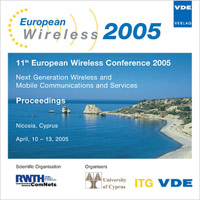Random Access in Overlapping Cells
Konferenz: European Wireless 2005 - 11th European Wireless Conference 2005 - Next Generation wireless and Mobile Communications and Services
10.04.2006 - 13.04.2005 in Nicosia, Cyprus
Tagungsband: European Wireless 2005
Seiten: 7Sprache: EnglischTyp: PDF
Persönliche VDE-Mitglieder erhalten auf diesen Artikel 10% Rabatt
Autoren:
Nguyen, Gam D.; Wieselthier, Jeffrey E. (Information Technology Division, Naval Research Laboratory, Washington, DC 20375, USA)
Ephremides, Anthony (Electrical and Computer Engineering Department and Institute for Systems Research, University of Maryland, College Park, MD 20742, USA)
Inhalt:
In this paper we consider cellular networks in which the cells may overlap substantially. Such network architectures, which are motivated by the need to increase the utilization of the available bandwidth by reducing the separation among cells that share the same channel, present new unexplored and fundamental problems. We begin by considering two cells whose assigned user populations overlap spatially, and use a common channel. Consequently, transmissions intended for one base station can cause interference at the other. The interaction between such cells is best exemplified if the protocol of access in each cell is pure random access. For Slotted Aloha, we present a simple mathematical analysis that predicts accurately the maximum achievable throughput. We demonstrate that an invariance (or “self-stabilization”) property exists that allows the maximum throughput to occur when the expected total channel traffic in each cell is equal to one packet per slot, independent of the degree of overlap of the cells. We then consider larger multi-cell networks and observe the same invariance property in our simulations. Consequently, in planar cellular networks there are no end effects, and coupling is limited only to adjacent overlapping cells. Thus it is possible to evaluate random access throughput by considering only the local neighborhood of a cell.


